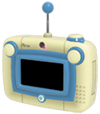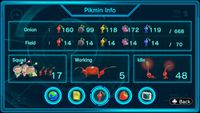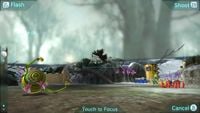KopPad: Difference between revisions
(Linking to the glitch.) |
|||
| Line 20: | Line 20: | ||
With Off-TV Play enabled, the player must press a certain button or tap a certain location of the GamePad in order to access the KopPad; this also pauses the gameplay. A certain button or icon on the screen will allow the player to return to the main gameplay display. | With Off-TV Play enabled, the player must press a certain button or tap a certain location of the GamePad in order to access the KopPad; this also pauses the gameplay. A certain button or icon on the screen will allow the player to return to the main gameplay display. | ||
=== | ===Radar=== | ||
[[File:KopPad map Go Here.jpg|thumb|left|300px|The | [[File:KopPad map Go Here.jpg|thumb|left|300px|The radar app, with Charlie ready to "Go Here!"]] | ||
{{ | {{main|Radar}} | ||
The ''' | The '''radar''' is the default app on the KopPad, and is always enabled if the player has [[Off-TV Play]] off. It provides a map of the area, stylized so that water, terrain, structures, and boundary walls are high-contrast and easy to distinguish. It has a static level of zoom, and by default, the map is centered on the active leader. | ||
{{clear}} | |||
===Exploration Notes=== | ===Exploration Notes=== | ||
Revision as of 11:17, May 11, 2015
The KopPad (GPAD in Japan) is a device used by the leaders in Pikmin 3. It is very similar to the Wii U GamePad. The device serves many purposes to help the characters through the game, and is likewise a gameplay mechanic for the player. The Wii U GamePad functions as this device during the game.
The KopPad can be personalized, as its screen rim color matches that of their owner: Alph's is blue, Brittany's is pink, and Charlie's is green. After crash-landing on the planet, Alph is separated from his KopPad. As a result, the player can't use it until the first bridge is built.
In Mission Mode and Bingo Battle, the KopPad can also be used, but it is more limited. In the latter, it has no extra apps at all, and only shows the map.
Apps
Besides allowing audio and video communication between leaders and the S.S. Drake, the KopPad also allows the explorers to read Data Files, get terrain and Pikmin info, store data on Fruits, and take pictures of the environment. For these latter purposes, the KopPad comes equipped with installable apps. Each app has an icon on the KopPad touchscreen that can be tapped to open the respective app. Some apps are installed at certain points in the game, and uninstalled apps appear with a × symbol on their icon. If new content was added to an app, the word "NEW" will appear under its icon. The five icons are as follows:
 The planet icon shows a birds-eye view of the currently explored area. This is the default app, opened while the gameplay is happening.
The planet icon shows a birds-eye view of the currently explored area. This is the default app, opened while the gameplay is happening. The Data File icon opens the Exploration Notes.
The Data File icon opens the Exploration Notes. The Red Pikmin icon opens Pikmin statistics.
The Red Pikmin icon opens Pikmin statistics. The Sunseed Berry icon opens a record of all collected fruits.
The Sunseed Berry icon opens a record of all collected fruits. The camera icon allows the player to take photographs of the in-game environment.
The camera icon allows the player to take photographs of the in-game environment.
Depending on the control scheme, the KopPad can be always enabled, or enabled on command. With Off-TV Play off, the player sees the main action happening on the TV screen, and the GamePad showing the KopPad's screen, with the map app opened. This app updates in real time as the gameplay takes place. If the player interacts with the GamePad's screen, the gameplay will pause, and provided they didn't switch apps, full control over the map app will take place. When the gameplay is paused, a pause symbol briefly appears on the pad's screen.
With Off-TV Play enabled, the player must press a certain button or tap a certain location of the GamePad in order to access the KopPad; this also pauses the gameplay. A certain button or icon on the screen will allow the player to return to the main gameplay display.
Radar
- Main article: Radar.
The radar is the default app on the KopPad, and is always enabled if the player has Off-TV Play off. It provides a map of the area, stylized so that water, terrain, structures, and boundary walls are high-contrast and easy to distinguish. It has a static level of zoom, and by default, the map is centered on the active leader.
Exploration Notes
The Exploration Notes are a collection of all Data Files found. The 120 Data Files are divided into six categories on this menu. This app is installed after one Data File is recovered. If a category has no unlocked Data Files, it merely appears as an × symbol. The following categories exist:
 Pikmin Behavior (Pikminology in the European version)
Pikmin Behavior (Pikminology in the European version)
- These files explain the behavior and abilities of the Pikmin.
 Controls
Controls
- This category tells the basic controls of Pikmin 3, as well as what to do in some special events.
 Indigenous Life
Indigenous Life
 Area Hints
Area Hints
- These notes provide hints on what to do in the immediate area.
 Olimar's Log
Olimar's Log
- These are personal notes from Olimar. They give an idea as to what Olimar has been doing on PNF-404 during the events of Pikmin 3.
 Other
Other
- This category is very different from the rest, in that it gives no helpful information or storyline. Each of these is a Secret File, with only a number and some Pikmin. Collecting all ten unlocks access to special cutscenes available online through the Wii U's internet browser only.
Pikmin Info
The Pikmin Info screen shows statistics about the Pikmin count. The top of the screen enumerates how many Pikmin there are of each type inside the Onion, as well as on the field (idle or not). The total number of Pikmin on the Onion and the total on the field are also present.
The bottom half of the screen has three more numbers: the number of Pikmin that are under a leader's squad, the number of Pikmin working, and the number of Pikmin idling.
Fruit File
The Fruit File is the fourth app on the KopPad. It is installed after the first fruit is recovered, and lists the types and amount of all collected fruits up to this point, sorted by order of collection. Tapping on a fruit will show its name, the amount of juice it's worth, how many of it have been collected, how many Pikmin are needed to carry it, Brittany's notes and finally, if the fruit radar has been unlocked, how many of this type of fruit there are in the game.
When the fruit radar is unlocked, the total number of existing pieces of fruit is also displayed, and the total of instances of each fruit also appears in the file. A star on the top-right corner of each cell indicates all existing samples of that fruit have been collected.
Camera
By opening the camera app, the player can use the GamePad much like they would use a real camera. The GamePad's screen shows the scenery from the view of the leader, holding the KopPad like a camera. As the player rotates and moves the GamePad, the changes are reflected in what's displayed on the screen. With this, the player can view the action from another perspective, and gain visual access to otherwise invisible details, such as the secret Pikmin drawings. While it is not possible to walk manually while holding the camera, it is possible to use the camera on a leader under the Go Here! command.
On top of allowing a pseudo-first person view, this camera also allows the player to take images and share them on Miiverse. ![]() can be used to zoom in and out, with the default level of zoom being 1.3×, the minimum being 1.0×, and the maximum being 3.0×. Touching a part of the frame will cause anything at that distance to focus, and scenery at other distances to become blurred; naturally, the farther it is, the further it blurs.
can be used to zoom in and out, with the default level of zoom being 1.3×, the minimum being 1.0×, and the maximum being 3.0×. Touching a part of the frame will cause anything at that distance to focus, and scenery at other distances to become blurred; naturally, the farther it is, the further it blurs.
![]() toggles the flash function. With it enabled, pictures will be taken with flash. This can be useful to lighten up otherwise dark pictures. Interestingly, the flash also causes an eyeshine effect on Bulborbs.
toggles the flash function. With it enabled, pictures will be taken with flash. This can be useful to lighten up otherwise dark pictures. Interestingly, the flash also causes an eyeshine effect on Bulborbs.
![]() takes a picture, and after a brief delay, the Pikmin 3 Miiverse post submission page opens up, with the photograph ready for upload. The player can set their mood, and add their own text and/or drawing to the submission. Depending on what was focused, the submission will automatically be tagged with one of the following tags:
takes a picture, and after a brief delay, the Pikmin 3 Miiverse post submission page opens up, with the photograph ready for upload. The player can set their mood, and add their own text and/or drawing to the submission. Depending on what was focused, the submission will automatically be tagged with one of the following tags:
- People: If the photo focuses on a character, playable or otherwise.
- Pikmin: If the photo focuses on a Pikmin or the Onion.
- Plants: If the photo focuses on a plant or pellet.
- Fruit from PNF-404: If the photo focuses on a fruit.
- Enemy name: If the photo focuses on an enemy, the post will be tagged with its name.
- Scenery: Anything else.
Pictures that are taken, whether they are posted on Miiverse, also have a chance of appearing on the area selection screen, when the area they were taken in is highlighted.
Gallery
- Movie09.jpg
Alph walking up to the KopPad.
- Charlie Communicating With Drake.png
Charlie using his KopPad to communicate with the S.S. Drake.
- GPAD.PNG
The KopPad's screen in Bingo Battle.
- Gamepad Communicator.jpg
Alph communicating with Brittany in a prototype version of Pikmin 3.
Trivia
- The device's name is a portmanteau of Koppai and GamePad. The Japanese version's name is GPad, a shortening of GamePad.
- Oddly, when a leader uses their KopPad to contact another explorer, the latter is seen not holding their KopPad. Although unlikely, it is possible that it is placed on a stand to allow a better view of the recipient, as they can be seen leaning forward to turn it off.
- It is unknown what Olimar and Louie use to communicate, but their devices appear to use similar technology to the KopPad, as they can contact the Koppaites and the Data File can be run by the KopPads.
- If the map app's orientation is set to the same as the camera's angle, there is a desynchronization between the angle shown on the KopPad and the TV screen's angle, on certain places. This can make it quite difficult to pan while looking at the TV screen. The following locations are affected (the angles provided are estimates):
- The cave with the Velvety Dreamdrop on the Tropical Wilds has a 45° difference.
- The Calcified Crushblat's arena has a 100° difference.
- Charlie's landing site on the Distant Tundra has a 90° difference.
- The log leading up to the Vehemoth Phosbat arena has a 15° difference.
- The first section of the Vehemoth Phosbat's arena has a 100° difference.
- The actual arena itself has a 45° difference.
- The Shaggy Long Legs' arena on the Distant Tundra has a 15° difference.
- The top of the Formidable Oak, still on the outside, has a 45° difference.
- Inside the Formidable Oak, the corridor area has a 45° difference, and the large section after has a 90° difference; the dark pond area is unaffected.
- By sliding the map on top of the Scornet Maestro's arena, toggling between the arena and the pathway leading up to it, and looking at the TV screen, one can notice that the "railing" on the pathway is considerably more simplistic and less detailed if the camera is focusing on the arena – notably, it's lacking the red leaves.
- If the player has a saved game that includes a day after the boss has been defeated, and then returns to a day where they have not yet visited the arena, the camera will reveal the Scornet Maestro high up in the center of the arena, in a T-pose. This is because the model is being used as a placeholder for the cutscene that triggers once the player goes to the top of the tree.






